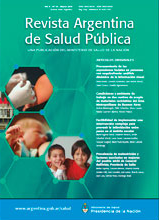Estimate of prevalence of antihipertensive drugs used in the Argentinian Integral Health Care Program for Elderly People
Keywords:
Hypertension, Drug Use, Pharmacoepidemiology, Social SecurityAbstract
INTRODUCTION: Arterial hypertension is highly prevalent in people older than 60, two thirds of which are covered in Argentina by the Comprehensive Medical Care Program (PAMI, according to the Spanish acronym). The objective of this work was to estimate the prevalence of antihypertensive drug (AHT) use in older adults of PAMI from the dispensation data and to describe its use in terms of type and quantity. METHODS: A retrospective observational study was conducted. AHT users were defined as adults of both sexes over 60 years of age who received at least 2 packs of AHT during 2018. The result was compared with the one yielded by the National Risk Factor Survey 2013. RESULTS: From the 4 397 188 beneficiaries of PAMI who were over 60 (63.8% women; average age: 74.3 years), 48.4% were AHT users during 2018 (women: 49.4%; men: 46.6%). This is similar to the 47.8% recorded in the National Risk Factor Survey 2013. The prevalence of use (PU) increased with age, from 37.5% at 60-64 years to 55.1% at 80-84 years, declining thereafter. PU adjusted for age and sex varied from 31.1% in Jujuy to 57.9% in Rio Cuarto. On average, 13.6 packs/user/year were dispensed. The most widely distributed AHTs were angiotensin II receptor antagonists (36.5%), beta blockers (27.0%) and angiotensin converting enzyme inhibitors (23.1%). DISCUSSION: The analysis of the administrative database of dispensed drugs allows the estimate of epidemiological data and to identify subpopulations that may benefit from specific interventions.
Downloads
Downloads
Published
How to Cite
Issue
Section
License
Copyright (c) 2020 Revista Argentina de Salud Pública

This work is licensed under a Creative Commons Attribution-NonCommercial-ShareAlike 4.0 International License.


